Looking for something different for your next family dinner or gathering with friends? Farm to Jar’s resident expert on everything Spanish, Maria, has an idea for you: a traditional Spanish seafood paella. It’s easier to make than you think and the perfect summer food for a crowd!

This post may contain affiliate links. As an Amazon Associate, I also earn from qualifying purchases. You can read our disclosure information here–
What is “Authentic” Spanish Paella?
Paella (pronounced pai·ay·uh) is a typical Spanish rice dish that originates from the Valencian region on the country’s Mediterranean east coast. The name of the dish refers to the pan that paella is typically prepared in, which is large and shallow, with handles on each side.
In Spain, and particularly around Valencia, paella is part of the local culture. The tourism sector has made it so that pretty much every restaurant on the coast serves paellas of varying qualities, but let me tell you a little secret…
The best paella is had at home with friends or family! It’s considered a lunch dish, maybe something for a Sunday afternoon: a dish that brings everyone together.
Having it for dinner is seen as blasphemy, by the way, but if you are not in Spain, I do think we can bend the rules a little.
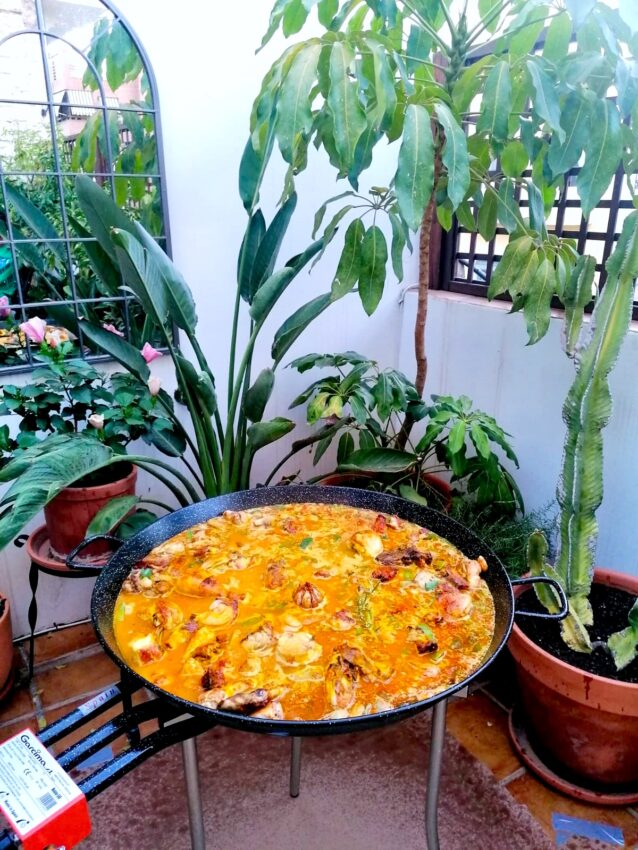
There are a few differences between an authentic Spanish paella and the “Americanized” version you’ll often see referenced in online recipes. For starters, for the Spanish version you’ll want to use an open fire, although a gas stove will do in a pinch.
You don’t use regular rice, but rather a type that’s referred to as “arroz bomba” in Spain, which I’ll tell you more about in a bit. There’s no wine involved, like in risotto, and no boneless meat please! The bones are where all the flavor is.
Let’s have a look at where paella came from, as well as the different types that you may encounter in Spain (and that you can consider making at home!). After that, I’ll share my tried and true authentic recipe for Spanish seafood paella for a crowd.
A short history of paella
Like many typical Spanish dishes, paella originated as food for the working class. It all started with the introduction of rice from Asia to Spain, around the time of Alexander the Great.
The Spanish mastered the growing of rice throughout the centuries, especially during the time the country was under Arab rule, for over 700 years from 711 C.E to 1492 CE.
When 15th-century Valencian farmers and shepherds were in need of an easy meal that could sustain them from lunch all the way to the end of the work day, they went for the logical option: rice.
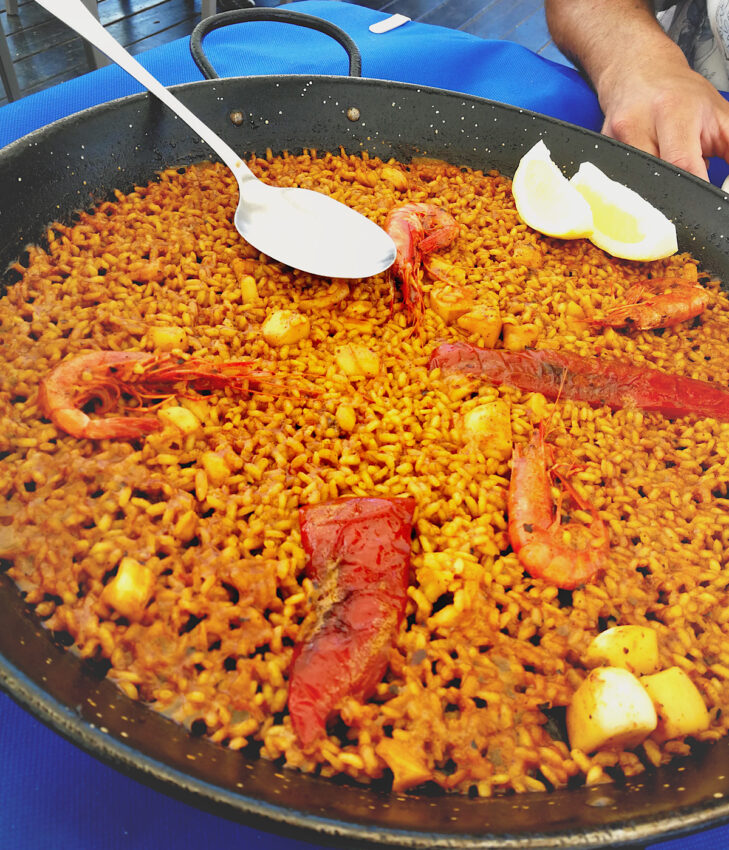
This rice was mixed with whatever vegetables and meat or fish they would have on hand at the time. It was quickly realized rice is fantastic at soaking up the flavor of stock and whatever else it’s cooked with, an advantage that ensured it slowly but surely became ingrained in Spanish culture.
Eventually, and inevitably, paella made its way to the USA and beyond during the 20th century. The tourism boom in Spain in the 1960s sealed the deal: everyone has now at least heard of paella, although not everyone has had the pleasure of trying an authentic one.
By the way, touristy restaurants in Spain are notorious for serving terrible paellas!
Types of Paella
Although paella started out as a “whatever” dish, with field workers tossing in anything they had on hand, set recipes have now long been established. There are three basic paella recipes, as well as a bunch of other arroces (rice dishes), which are prepared in a similar manner but don’t carry the official name.
As with all traditional Spanish dishes (lookin’ at you, gazpacho!), the ingredients for paella are subject to some internal dispute. Everyone’s family makes it slightly differently.
However, there are some basics that all Spaniards agree on, and woe unto you if you dare to change the recipe!
Let’s have a look at the different types of paella you can try, as well as some of the other common arroces.
‘Authentic’ Valencian paellas
There are three true traditional Valencian paellas:
- Meat-based
- Seafood-based
- Mixed
They all use saffron as a typical coloring/flavoring and can be finished off with a squeeze of fresh lemon.
Funnily enough, a habit I’ve seen in the Alicante region, close to Valencia, is to also serve paella with aioli (garlic mayo). I’m not sure if the Valencians themselves would agree with that, though!
Here are some photos of each type of paella made on our outdoor hob:
- Meat (or ‘valenciana’): Traditionally made with chicken and rabbit meat (or duck), plus pole beans, grated tomato and possibly artichoke and butter beans. The broth that the rice is cooked in is often created in the pan itself, although home cooks tend to cheat and use chicken broth to make things a little easier.
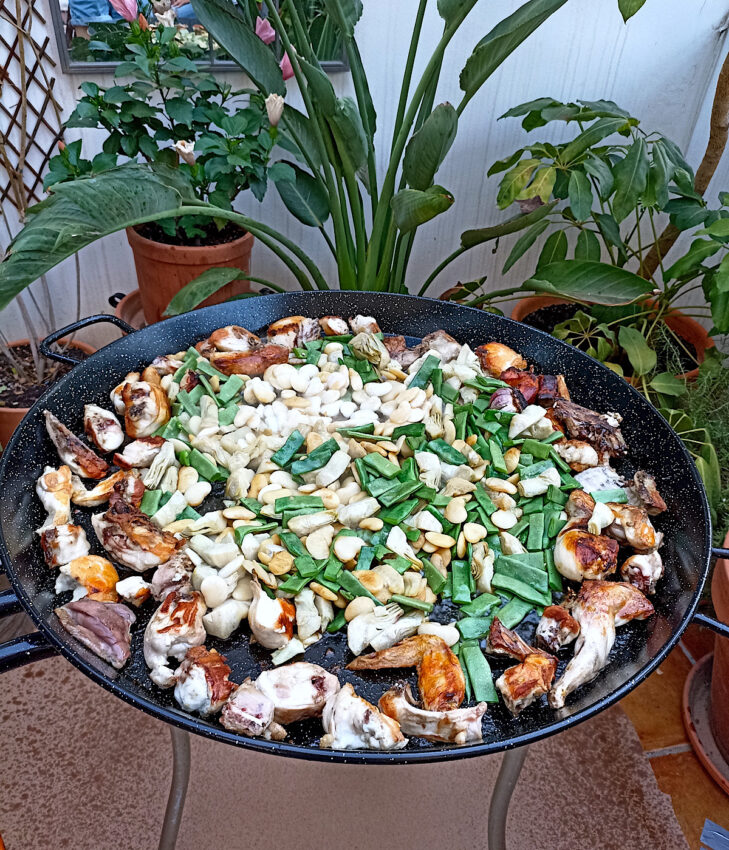
- Seafood (‘de marisco’): A range of different seafood (shrimp, mussels, squid and sometimes scampi) is combined with a seafood broth and different seasonings. Vegetables like red pepper, onion and peas are sometimes added, but it’s not traditional.
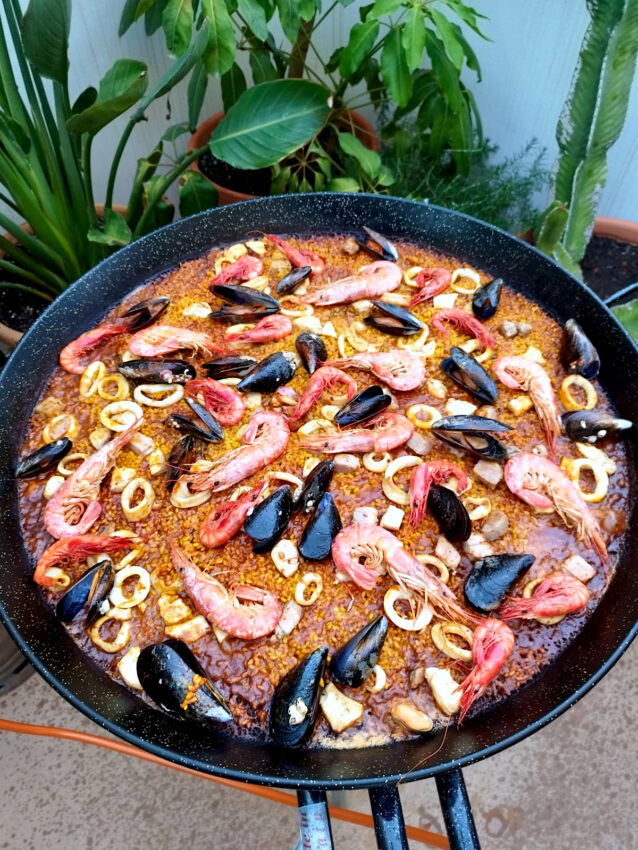
- Mixed (‘mixta’): Not as popular in Valencia itself, this is the best of both worlds and found throughout the rest of Spain.
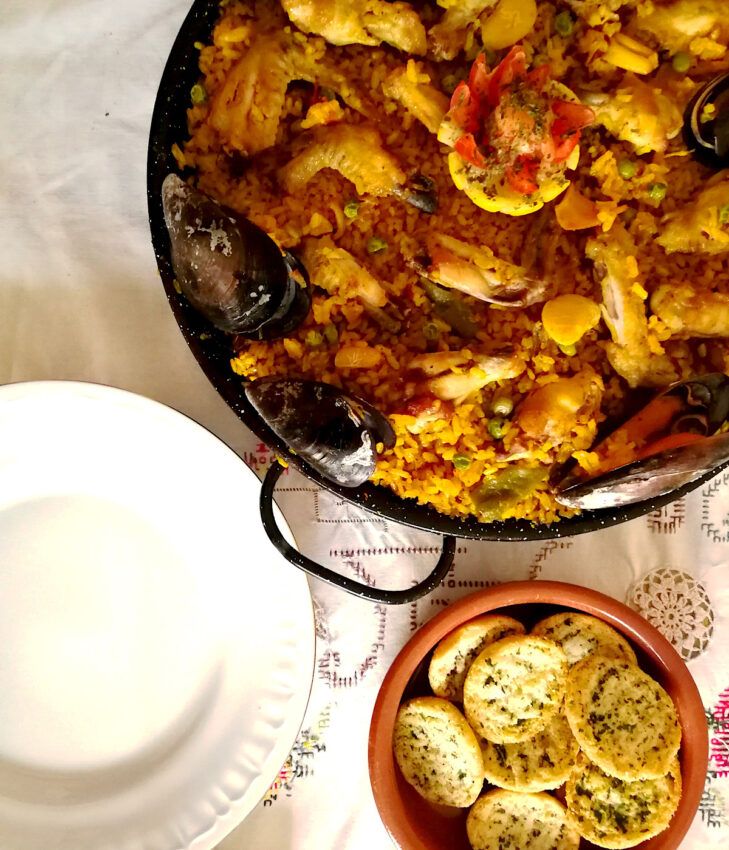
Other Traditional Spanish Rice Dishes (arroces)
Tried all three of the traditional paella varieties and still hungry for more? Fear not! There are endless rice dishes to try that are prepared similarly, with a range of different ingredients.
Why not try:
- Arroz negro (black rice): It might sound strange to us, but arroz negro gets its color from squid ink, which is easy to find in Spanish supermarkets. It’s a seafood dish with squid or cuttlefish, as well as prawns.
- Arroz del Senyoret (gentleman’s or fancy rice, due to the fact that all seafood is pre-peeled): Very common in my neck of the woods. This one’s made with fish stock, squid, shrimp and monkfish or rehydrated dried cod.
- Arroz a banda (rice on the side): A traditional fisherman’s dish that involves homemade fish stock and is served with prawns and cuttlefish.
- Fideuà: Made with small pasta noodles rather than rice, this dish usually contains monkfish, cuttlefish, squid and shrimp.
- Arroz meloso: Although the preparation is a little different, this rice dish (which can be made with different ingredients) is characterized by the fact that its texture is similar to that of risotto rice.
- Arroz caldoso: More of a rice stew, arroz caldoso can be made with different ingredients, but is always easy to recognize due to its soupy texture.
- Magro y verduras: I just have to give one of my personal favorites a shout-out! This rice dish is made with magro (a pork cut with very little fat) and vegetables like green beans and artichoke.
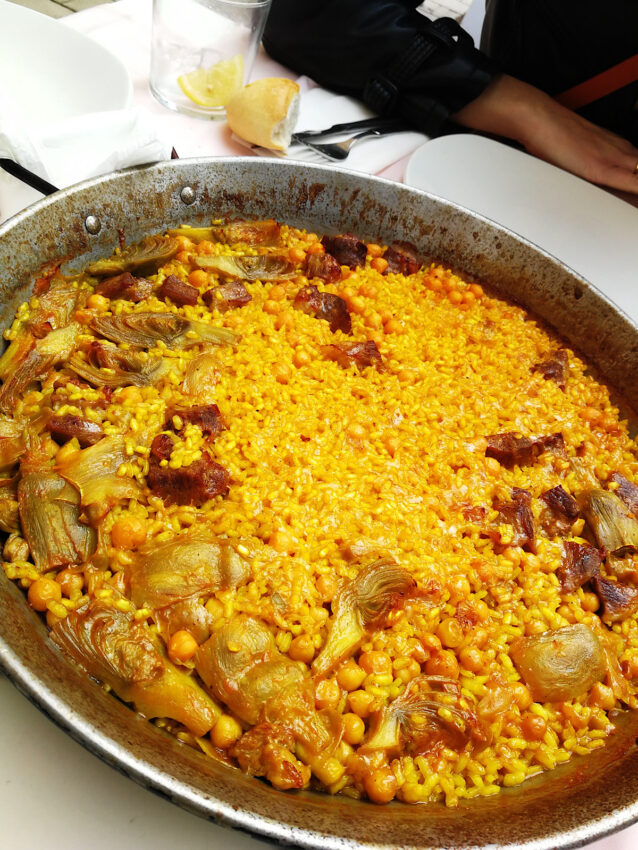
Did you know? The biggest paella ever was made in 2001, in a pan that was 21 meters (almost 70ft) wide. It contained an entire kilo of saffron!
How to Make a Traditional Spanish Seafood Paella
Let’s dive into how to make a traditional Spanish seafood paella (better known as paella de mariscos) at home! This is the perfect dish for a crowd.
I’ve been living in Spain for over 4 years and my friends and I get together for a paella cookout at least every few months. Serve some wine and appetizers, play some music and get cooking. Everyone can help.
We make our paella outdoors using a special gas burner with a large ring that can fit our XL paellera. If you’re planning on making this dish regularly, it’s an absolute lifesaver!
However, you can also make yours on a charcoal barbecue or even over a campfire. Even your regular stove works, although you may have to get a large ring or rotate the pan regularly so everything cooks evenly.
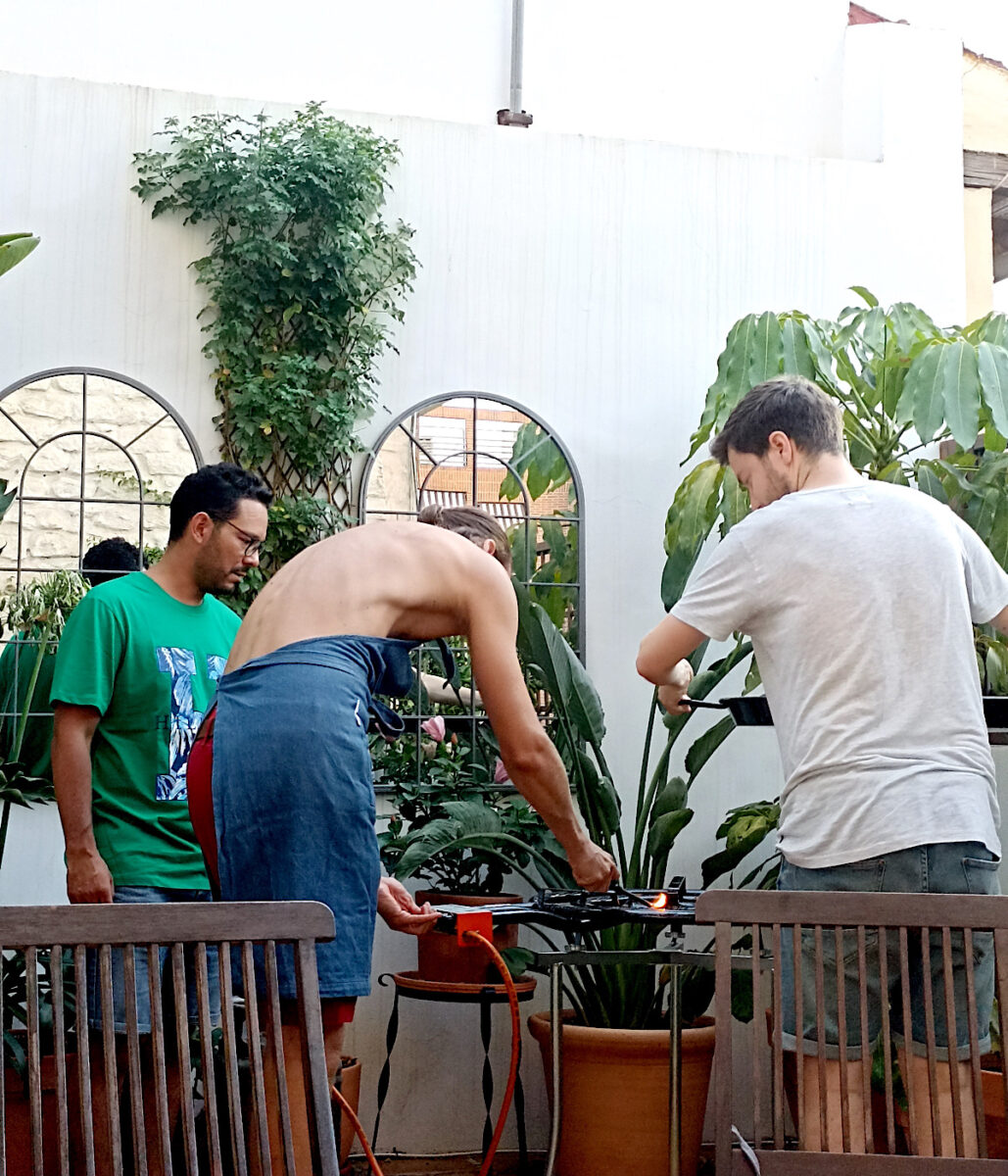
Ingredients & Substitutions
In the recipe below, I’ll tell you how to make a traditional Valencian seafood paella. Since some ingredients may be a little more difficult to find in the US, I’ll also list a few substitutes for those who don’t feel the need to follow the traditional recipe to the letter.
Please don’t tell the Valencians that I did, though: they take the traditions extremely seriously. You won’t find peas or chorizo in this one, as that might get me hate mail.
Here’s what you’re going to need:
Seafood
- Fresh, live mussels (substitute: frozen with shell)
- Fresh squid or cuttlefish, in rings (substitute: frozen, unbreaded calamari)
- Fresh shrimp or prawns, shell-on (substitute: frozen, but with shell please, since it lends lots of flavor to your dish!)
- Optional: fresh clams (or frozen with shell)
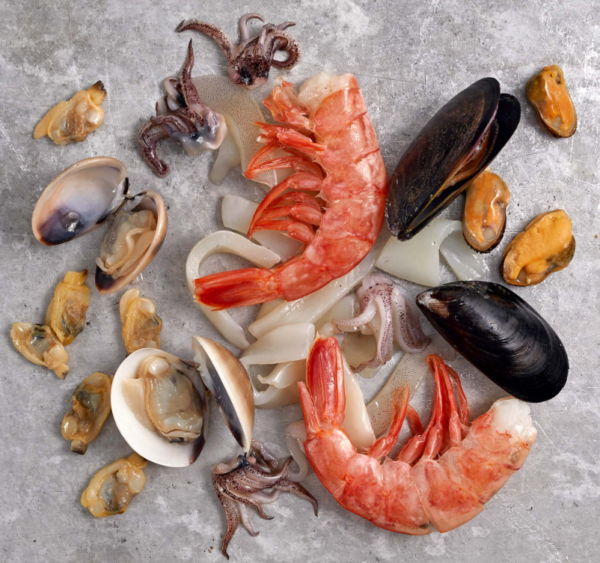
You can include other seafood that you like (I have seen arroces with lobster, for example), but these are the classics. If you want to turn your dish into a paella mixta, you can also add some chicken legs. Just treat those like you do the seafood during the preparation.
Vegetables
- Garlic: have you ever seen a Mediterranean dish without it?!
- Grated tomato: something we don’t use much here in the US, but it is actually a classic paella ingredient.
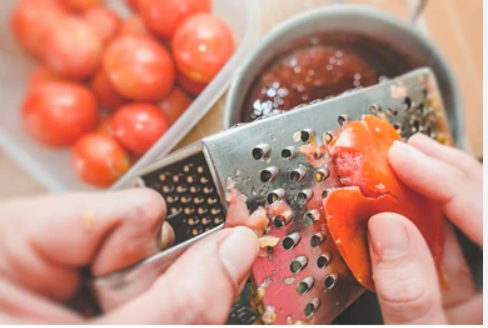
Spices
- Saffron (substitute: you can look for paella seasoning with food coloring)
- Sweet paprika: for color and a mildly smoky flavor.
- Optional: parsley, although this is not traditional.
The photo below shows bright orange saffron threads which come from the purple crocus flowers. More information plus this photo can be found at insider.com.
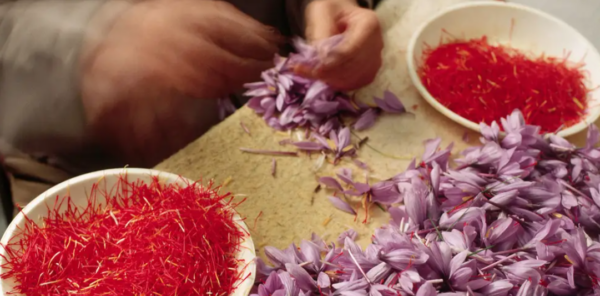
Other Key Ingredients:
- Arroz bomba/Valencian rice: there really isn’t a substitute for this because the texture is so specific. Risotto rice looks similar, but is much too starchy.
- Fish stock: a homemade one would be fantastic, but buying it is not frowned upon. Try to get a quality stock, since it will determine much of the flavor of your paella.
- Olive oil: again, have you ever seen a Mediterranean dish that doesn’t have this in its ingredient list?

Enjoy the fruits of your labor!
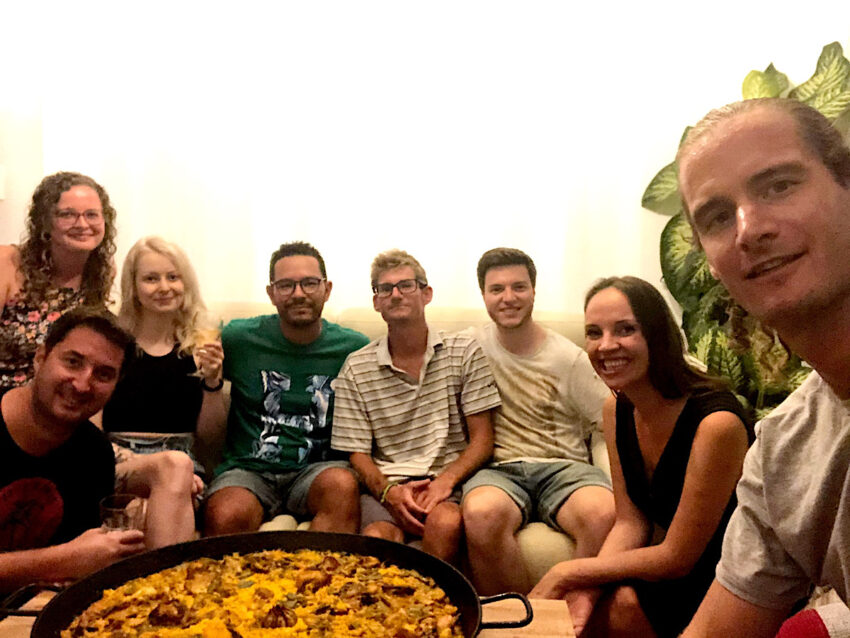
Frequently Asked Questions:
Because paella traveled around the world and back in the 20th century, the definition has become a bit muddled for many people. Let’s have a look at some common questions for those looking to make a real, traditional Spanish paella!
Your Spanish seafood paella will taste fine with chorizo, but it would absolutely not be traditional anymore. Just think back to when Jamie Oliver’s website published a recipe for paella with chicken and chorizo: half of Spain jumped on the internet to yell at him!
Spanish seafood paella will go well with white wine and some nice (garlic) bread. As I mentioned earlier, some Spaniards will eat it with aioli.
In an airtight container, paella will last 3-4 days. If you won’t be able to finish it all, just freeze it! Paella freezes very well and will last for months.
You’re not the only one who has asked this question. Spaniards have clearly dealt with the same issue, because a look at the spices for sale in Spanish supermarkets will reveal something called paella seasoning. This gives paella its typical yellow coloring without the saffron. There are also paella seasonings that do contain some saffron, but are still cheaper than buying this precious spice outright.
Move over basmati and jasmin! Paella is made with typical Spanish rice called “arroz bomba”, which is similar in appearance to risotto rice. This is a short-grain rice variety that can absorb a lot of liquid without losing its structure and without sticking. It’s sometimes sold as “Valencian rice” in the US.
Socarrat is your new best friend, and also the reason paella can’t be made in the oven as some recipes suggest. It refers to that beautiful layer of slightly burned rice at the bottom of the paella pan: toasted, crispy and delicious.
I’ll give some tips on obtaining this holy grail of paella in the recipe at the bottom of this article.
This is gonna crack you up… you don’t actually use fish in a traditional Spanish seafood paella! The ingredients are limited to squid or cuttlefish, and shellfish like shrimp, scampi, mussels and/or clams.
If you want to make a traditional Spanish rice dish with fish, you can try arroz del senyoret, which is usually made with monkfish (although any firm white fish should be fine).
Paella is not a dish you eat alone. The more, the merrier, although remember, a bigger crowd means a bigger pan will be needed. If you wonder how large your paella pan (paellera) should be, here are some diameters you could go by:
40 cm/15.5″: Up to 3 people
55 cm/21.5″: Up to 5 people
65 cm/25.5″: Up to 7 people
80 cm/31.5″: Up to 10 people
90 cm/35″: Up to 12 people
Yes! Just don’t go for a non-stick pan – that would make it impossible to get a nice socarrat. A normal stainless steel skillet works, although you’ll have to find a big one if you want to feed a crowd.
If you enjoy all types of Mexican food, check out this category of ALL Mexican recipes, where you will find over 40 Mexican recipes, from casual, to low carb, to fancy.
Traditional Spanish Seafood Paella
Equipment
- Paella pan (paellera), at least 23.5" in diameter or a large stainless steel skillet
- Heating source paella gas burner, barbecue, open fire, stove
- Kitchen towel enough to cover your paellera
Ingredients
- ⅓ cup oil
- 10 mussels live and de-bearded if possible
- 10 shrimp or prawns with the shell
- 5 squids about 1 pound, in rings
- 8 clams optional, live is best
- 5 chicken legs optional
- 10 cups fish or shrimp stock
- 3 cups arroz bomba (Valencian rice)
- 5 cloves garlic
- 2 cups grated tomato
- 1.5 tablespoons sweet paprika
- 10 strands saffron or paella seasoning according to instructions on container
Instructions
- Place the paellera on a medium flame to heat the oil.1/3 cup oil
- Sear the squid and shrimp for 1-2 minutes, but not until thoroughly cooked. Remove and set aside. Do the same with the chicken, if you're using it.10 shrimp or prawns, 5 squids, 5 chicken legs
- Toss in the mussels and clams and cook just until they open, which will be quick. Take them out and set aside. There will be some liquid in the pan, but that's no problem.10 mussels, 8 clams
- Quickly sauté the garlic until golden brown; this shouldn't take more than a minute.5 cloves garlic
- Add the grated tomato and let cook for 5 more minutes.2 cups grated tomato
- Add the rice and paprika powder, (plus the paella seasoning if you're using it instead of saffron). Stir to coat the rice and sauté for around a minute.1.5 tablespoons sweet paprika, 3 cups arroz bomba
- Turn down the heat (or move the paellera to a cooler part of the fire). Add the stock and then the saffron. Stir once.10 cups fish or shrimp stock, 10 strands saffron
- Leave the rice to simmer in the broth for around 20 minutes before giving the broth a taste. Adjust the salt if need be, but without stirring. It's normal for the rice to brown at the edges of the pan, and with a bit of luck, the same will happen on the bottom: your delicious socarrat.
- Now, how much longer it will take the rice to absorb the broth and be done will depend on your cooking method. You can give it a taste every five minutes until it reaches "al dente" consistency (ever so slightly undercooked, but almost done). If the broth is gone but the rice isn't cooked yet, add some water.
- Once you feel the rice is almost done, add the mussels and clams, plus the seared squid and shrimp. Just lay it all on top, don't stir.10 mussels, 5 squids, 8 clams, 10 shrimp or prawns
- When the rice is fully done, take the paellara off the fire and cover the whole thing with kitchen paper or kitchen towel for at least five minutes.
- Serve! We usually use a slotted spoon for this. You may have to scratch the bottom of the pan a bit, as the socarrat will stick. Don't forget to place an extra plate in the middle for everyone to dump their shrimp and mussel shells.

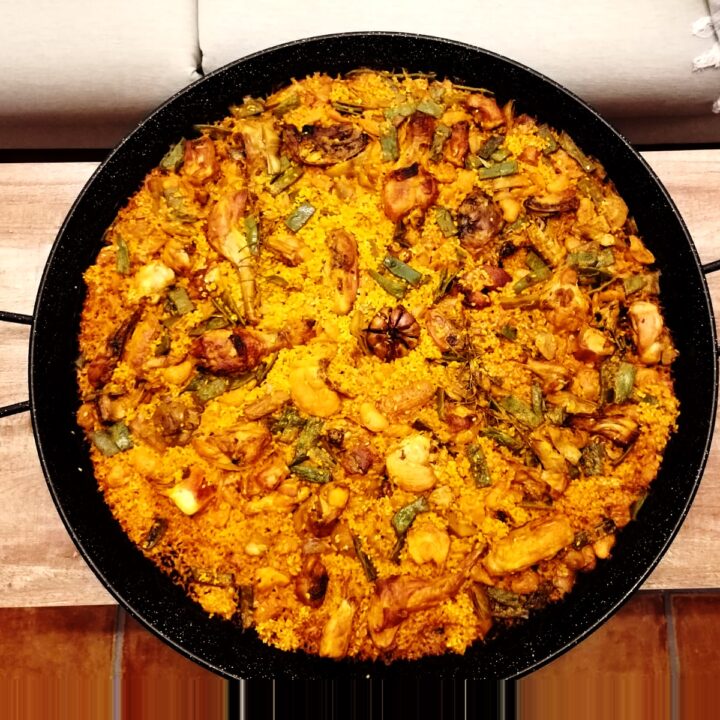
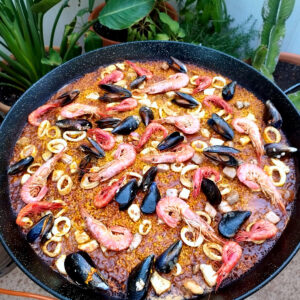
Leave a comment